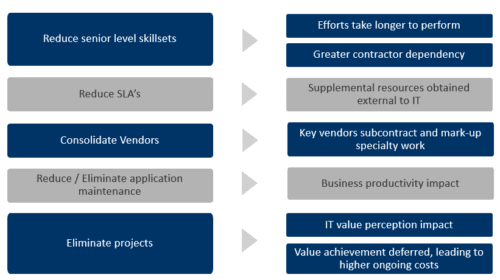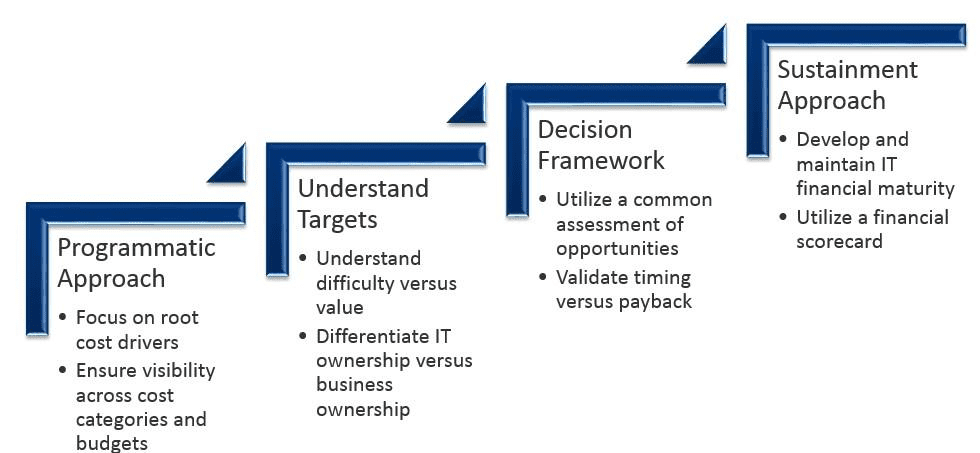This article is part two of a four-part series on optimizing IT costs.
Past technology investments should have enabled new business improvements or efficiencies, but often come at the price of long-term operational maintenance and capital renewal increases. Sudden pressures to reduce this cost must be weighed against impact to the efficiencies and capabilities previously delivered. Knee-jerk cuts on IT spend in areas such as labor, application maintenance, or innovation budgets could significantly reduce competitiveness coming out of the downturn. However, cost efficiencies are almost always possible as they are rarely vetted on a continuous basis within IT. Balancing these two truths requires an analytical and collaborative approach that reviews IT spend and impact across all budgets, both internal and external to IT.
Focusing on cost cutting within budget silos rarely results in measurable, sustainable efficiency gains. Short-term budget reductions may be achieved, but often at the price of even larger budget requirements or significantly delayed benefits. The desire to comply with a quick-win budget reduction can obscure detailed analysis of the reduction impact.
Many typical cost-cutting tactics deliver negative effects which erode delivery capabilities, bringing IT out of alignment with business expectation or causing a budget overrun in a different area. When a decline in oil price is the key factor in seeking efficiencies, delaying costs or pushing costs to a different area will not achieve the desired outcome.

Without analysis and program oversight, seemingly straightforward cost improvement efforts can quickly drive unanticipated consequences. Rectifying each of these situations may ultimately cost more than the reduction ever achieved.
Critical Success Factors
Identifying, analyzing, and capitalizing on cost optimization opportunities is dependent on several critical success factors.

Programmatic Approach
In order achieve successful impact on IT value, the cost optimization effort requires a holistic programmatic approach. The focus must shift away from individual cost drivers toward a model of transparency. The most impactful initiatives will cross multiple IT budgets and may impact various areas differently. In fact, many of the largest reductions could require an investment in another part of IT or within the business.
The programmatic approach is required in order to understand cost and opportunities, not only within budgets, but across functional areas of IT. An additional element of analysis must consider the accountability and ownership of the opportunity. While many cost opportunities are completely within the influence of IT, others may require business agreement or full business leadership.
Understand Targets
Each optimization target will require detailed analysis to understand the impact, risk, commitment, value timing and level of business commitment required to optimize successfully. Trade-offs exist between these factors within each target. Understanding the impact of these trade-offs, and the level of business sponsorship required will drive the target selection, timing and achievable levels of optimization, allowing for transparent and comprehensive decision making.

Initial target identification often falls within IT ownership and focuses on IT controlled areas, with minimal requirement for business consensus. Optimization around IT contracts, vendor pricing, consolidation efficiencies, or standardization efforts are frequent optimization targets, worthy of consideration. However, focusing only within IT owned targets limits the total program opportunity. Internal IT targets can often yield up to 15% reductions in overall IT expenditure within some environments. Opportunities which require business sponsorship, such as application rationalization, restructuring, process automation, or business decision enablement, can far exceed a 15% target.
Lawrence Eribarne is a Principal at Enaxis Consulting with over 20 years of experience as a technology leader performing IT organizational transformations as both an industry leader and IT advisor. Lawrence has a cross-industry background covering media, technology, military, and a strong emphasis on energy and manufacturing.






